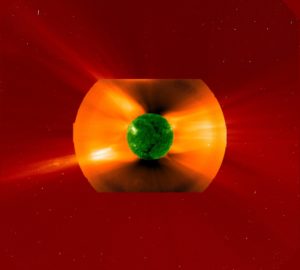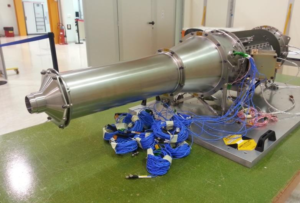The Solar Physics Group
at Turin Astrophysical Observatory
Description
In Turin, the interest in space solar physics, aimed to study flares and eruptions, dates back to the eighties, thanks to the Italian involvement in the Solar Maximum Mission.

Later on the Turin solar physics group had a key role in the development and operations of the UVCS instrument, observing the corona on-board the SOHO spacecraft (launched in 1995) in a flawless manner for 16 years. The team is presently coordinating the Metis project for the ESA – Solar Orbiter mission. Metis is developed in collaboration with the Italian space solar physics community.
The main research field of the group is the solar corona where the solar wind is accelerated and solar eruptions originate and propagate. Solar eruptions are the main drivers of geomagnetic storms. Hence, understanding and monitoring this region of the Sun is crucial for Space Weather forecast. Coronal observations from space are in fact unique in providing propagation direction and speed of solar eruptions: the starting point of any space weather prediction.
Personnel
E. Antonucci, S. Fineschi, L. Abbo, A. Bemporad, C. Benna, G. Capobianco, M. Casti, A. Cora, F. Frassati, S.
Giordano, S. Mancuso, G. Massone, G. Nicolini, R. Susino, D. Telloni, A. Volpicelli, L. Zangrilli.
Main Research Fields
Physics of the solar corona, understanding the origin and evolution of the main drivers of Geomagnetic
Storms: Solar Wind and Coronal Mass Ejections (CMEs).
Methods
- Development of coronal instrumentation for future space missions and ground based observations.
- Coordination of observational campaigns from space and ground (total solar eclipses).
- Development of diagnostic techniques for the analysis of coronagraphic and spectroscopic data acquired from space and ground.
- Modelling of coronal emission for data analysis and inversion.
- Archiving and cataloguing space solar data (the SOLAR archive includes the data of 11 over 12 SOHO
instruments) and in particular coronal data (UVCS) and in the future Metis (Solar Orbiter), and ASPIICS
(PROBA-3).
Projects

The group in Turin is actually involved in several international projects with leading roles (see Table). The Metis coronagraph, the Italian instrument for Solar Orbiter, will provide the first ever simultaneous visible light and UV images of the solar corona. This will occur from the unique vantage point offered by the ESA-Solar Orbiter spacecraft (first ever close-up observations of the Sun from 0.28 AU, and out-of-ecliptic view of the Sun from up to more than 35°). The ASPIICS coronagraph on the ESA-PROBA3 satellite will test for the first time the feasibility of coronagraphic observations from space obtained by maintaining with sub-mm precision the formation flying alignment between two spacecraft (the occulter and the telescope spacecraft) at a relative distance of 150 m. SCORE, in its second rocket flight, will carry out observations of the corona in visible light and in UV Hydrogen and Helium emission lines (in the first flight SCORE has provided the first determination of the He abundance in corona). The ESCAPE project will test the feasibility of coronal magnetic field monitoring from the ground: the dynamics of the solar corona is dominated by the magnetic fields, but the measurements of these fields are very difficult, thus limiting our actual understanding of solar eruptions and solar wind acceleration. The SWELTO – Space WEather Laboratory in Turin Observatory is a conceptual framework where new ideas for the analysis of space-based and ground-based data are developed and tested. The aim of SWELTO is to test new data-analysis methods for future applications for Space-Weather monitoring and prediction purposes.
The Group is also responsible for the OPSys facility (Optical Payload System) a clean room (certified ISO 5/6) located in ALTEC and hosting the Space Optics Calibration Chamber (SPOCC).
| Project Name | Short description & website | Role | Timeline |
|---|---|---|---|
 | VL and UV Coronagraph for ESA-Solar Orbiter spacecraft → first close-up (0.3 AU) observations of coronal plasmas Metis website | Development of the Metis coronagraph (PI: E. Antonucci) | Launch: October 2018, nominal mission 4.5 years |
 | VL coronagraph for ESA-PROBA3 satellite → first eclipse-like, long-term observations of the inner corona Proba-3 website | Italian coordination for Formation Flying metrology (Lead Co-I: S. Fineschi) | Launch: 2019, nominal mission 2 years |
 | Helium Sounding rocket coronagraph → first determination of coronal Helium abundance Score website | Responsability of the SCORE coronagraph, second flight (PI: S. Fineschi) | First launch: September 2009, Second launch: June 2016 |
 | Coronagraph in Antarctica (Concordia base) → first long-term coronal magnetic fields monitoring | Leader of the Italian instrument consortium (Co-PI: S. Fineschi) | Deployment: 2017, nominal duration 3 years |
 | SOHO long-term Archive at Turin Astrophysical Observatory → archiving and cataloguing space solar data Solar website | Hosted at and maintained by INAF-OATo observatory | Established in 1996, still active |
 | Space-Weather early-warning mission for ASI solar-photon sailcraft → Phase-A study of a payload for CMEs early-warning from L1 | Leader of the INAF consortium for payload study (Co-I: S. Fineschi) | Phase-A study 2020-2023 |
 | Space WEather Laboratory in Turin Observatory → conceptual framework to develop and test new ideas and tools for the analysis of space- and ground-based data for SW applications | Developed and hosted entirely by INAF-OATo (PI: A. Bemporad) | Established in 2017, currently under development |
Group web page
Contact person: Alessandro Bemporad
